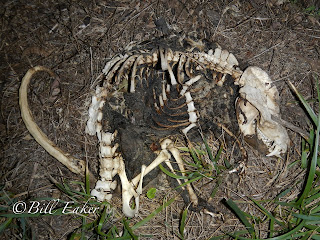I got out a couple of times this weekend and it was bitter cold with fierce wind. I headed over to Annawan, and the roads were horrible. There were a dozen cars off the road! I really didn't expect to see anything that first day after the storm because it was so bad. I figured most of the critters took cover and were hunkering down until it was over. I didn't see any tracks at all, and I started to believe I might be correct. However, the little mink below proved me wrong. It was headed back to the den with a hearty breakfast of fish.
I ventured out a little closer to home yesterday and on my way to my destination, I spotted 4 coyote in a field next to the canal path. I have only seen solitary coyotes around the canal in the daytime, but these guys were hanging together. They were just hunting and lounging. I pulled over on the side of the road and just enjoyed watching them for awhile. I was hoping to see some rodent pounces, but it never happened.
I was pretty sure that they had followed the canal path to that field since it is the only tree cover in the area, so I went up a couple of bridges to see if I could find their route. Sure enough, I found four direct coyote trails on the main path headed in the direction of where I had last seen them. So much can be learned from animals just by following and studying their paths.
The snow reveals every little nook and cranny that they investigate. Coyotes mark with their urine frequently, and of course, this is easily spotted. Don't eat the yellow snow! If followed their path for a little more than 2 miles, and between the four of them, there were 13 urine spots.
Of course they left other little presents along the way as well. Every scat i found was directly on this snowmobile track.
The tracks led up to the edge of the canal where apparently they had taken a little snooze break. These little "beds" were nicely formed, to keep the wind at their backs. I was a bit disappointed in the photos because these were perfectly formed little beds which can only be appreciated in person (or in 3D). I could just picture them all curled up in little balls of fur trying to keep warm. These beds were pretty fresh as there was very little snow in them, and the wind was still blowing.
I also found a spot where one coyote had pounced. I'm assuming it was a rodent tunneling, as there were no other tracks. A few feet away, there was a bit of evidence that the pouce was successful. Tiny droplets of blood!
I tracked them all the way back to where I had first spotted them, and sure enough, they were still in the field. Unfortunately, my tracking adventure stopped at the fence to the local farmer's field:( I would have loved to try to get closer for some better photos, but maybe next time.
On the way back to the truck, I focused on getting some wildlife shots and came up with one final surprise. This barred owl startled me as it bolted from a low lying tree, but not enough to keep me from getting a couple of shots.
The Hennepin holds many wildlife secrets, but many are revealed when the snow falls. Get out there and see what you can find! Merry Christmas everyone!










































